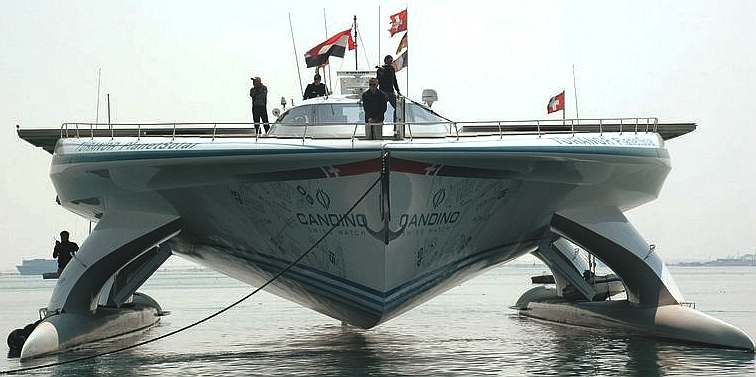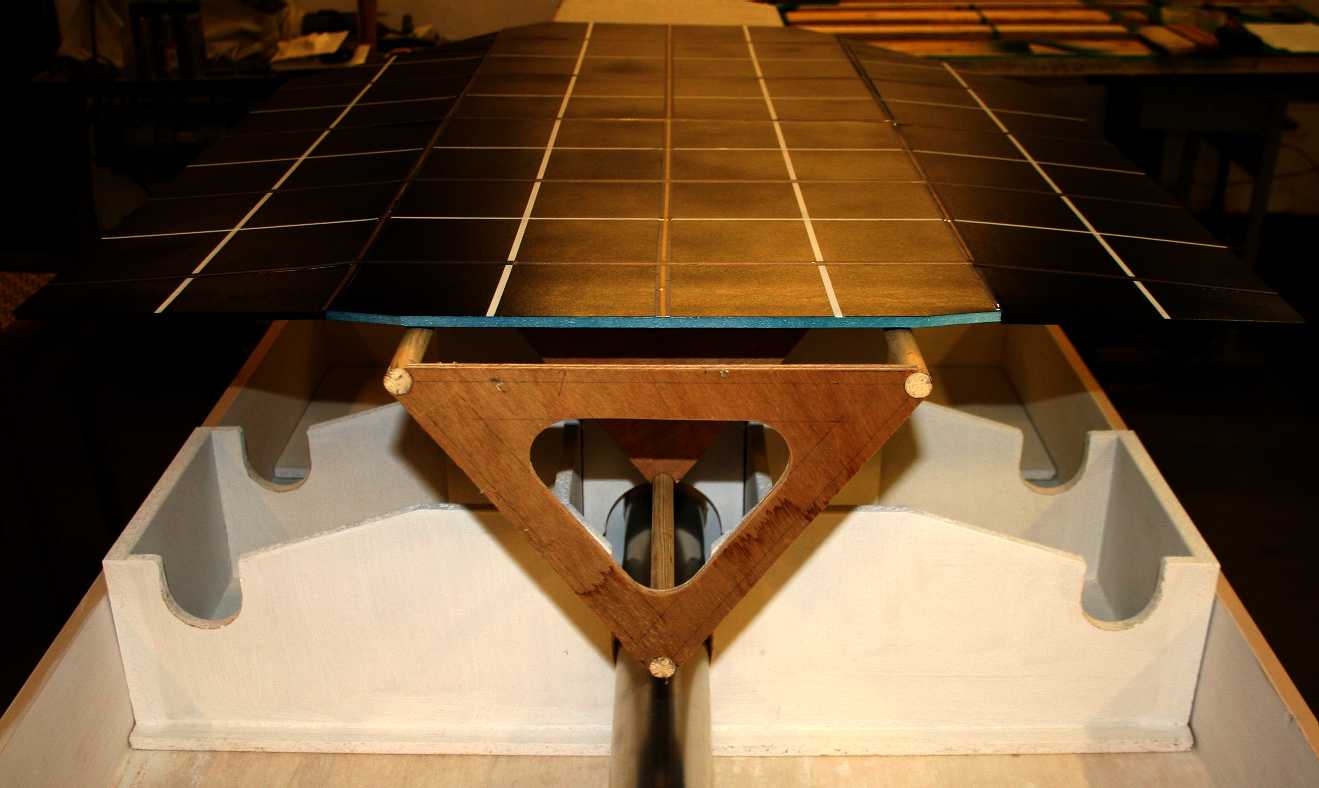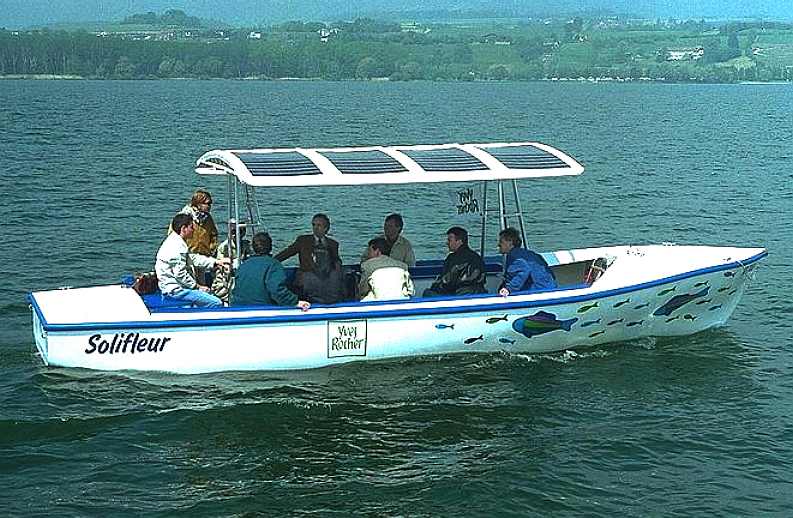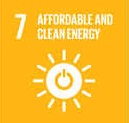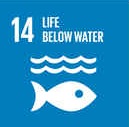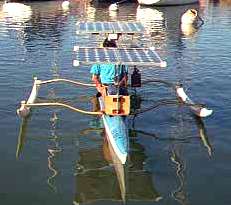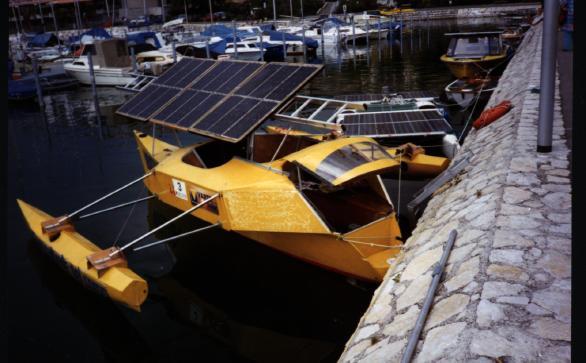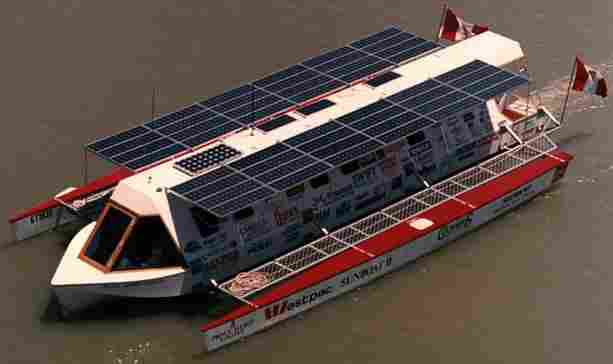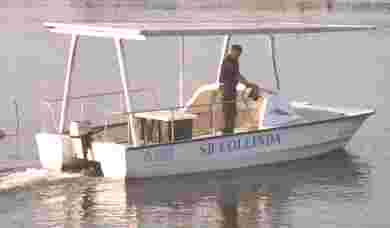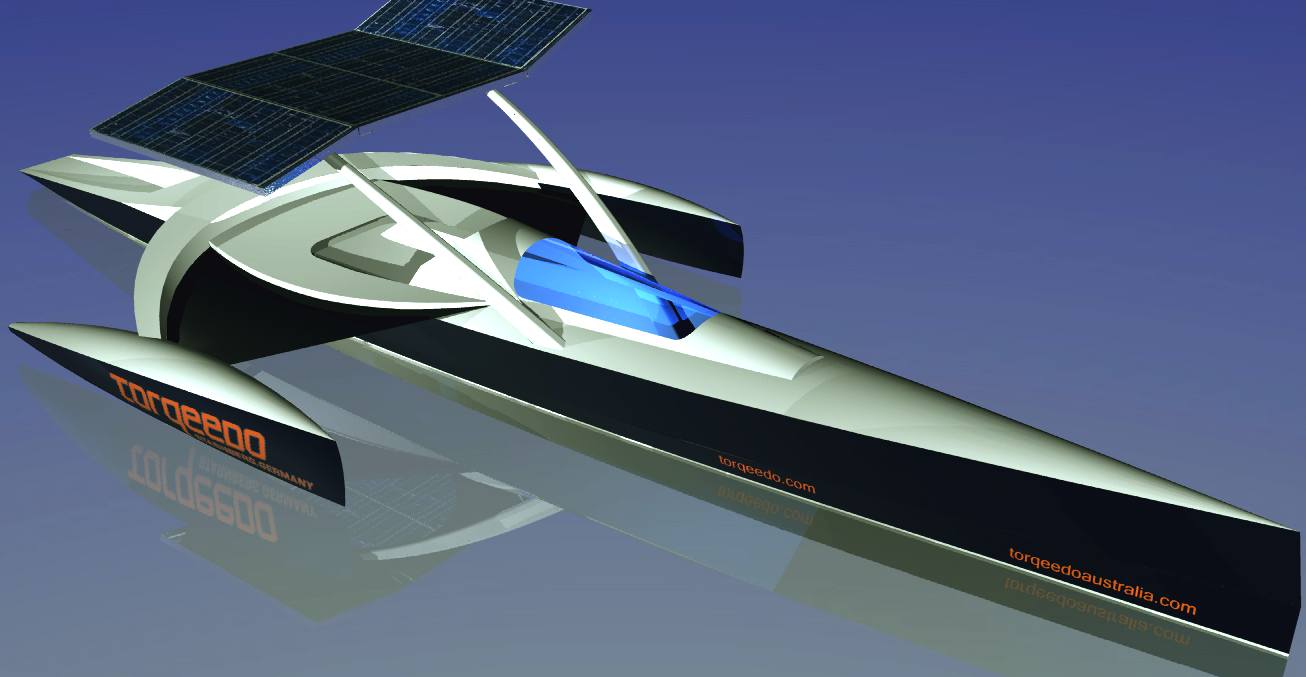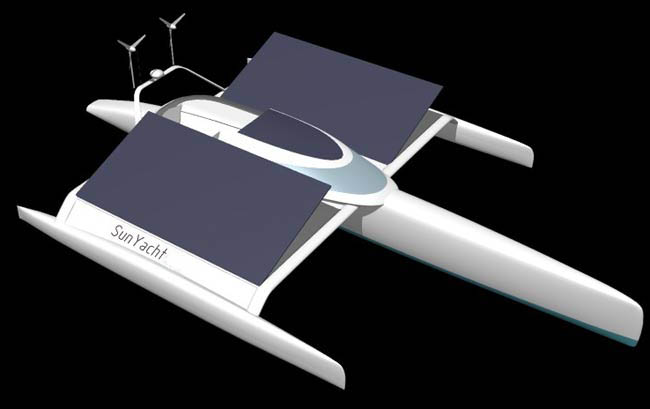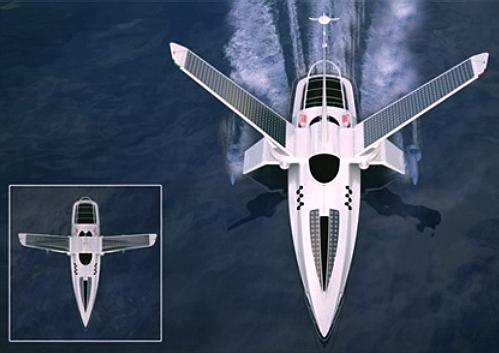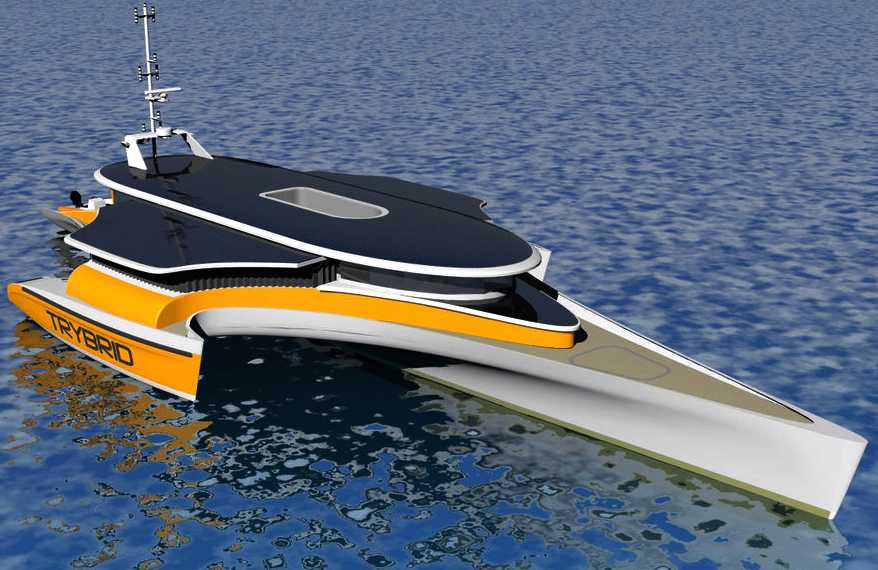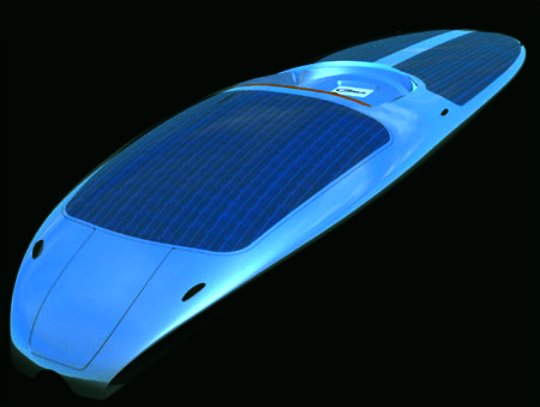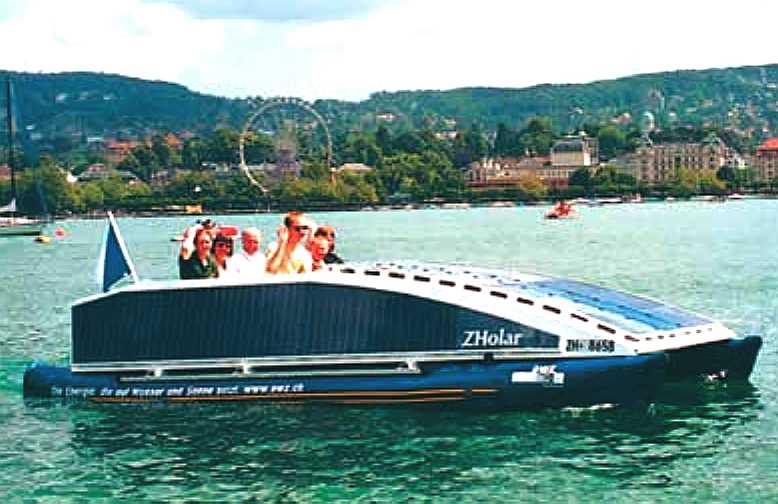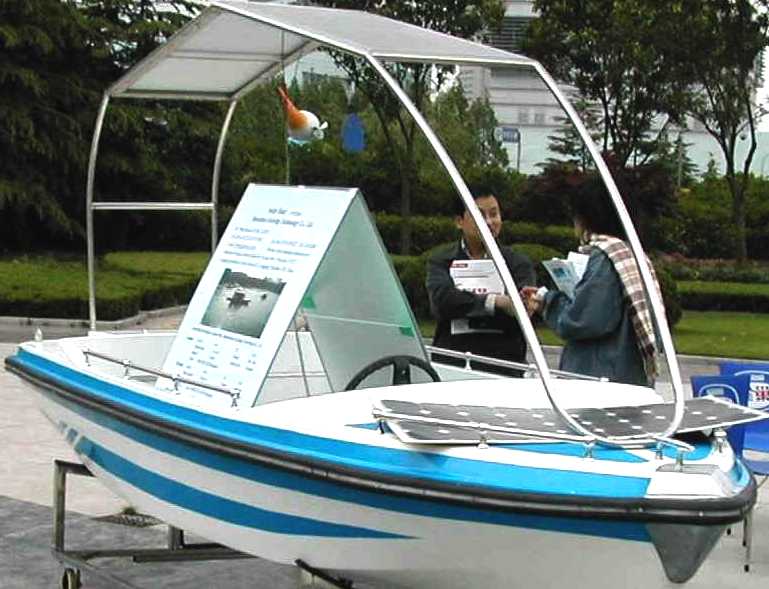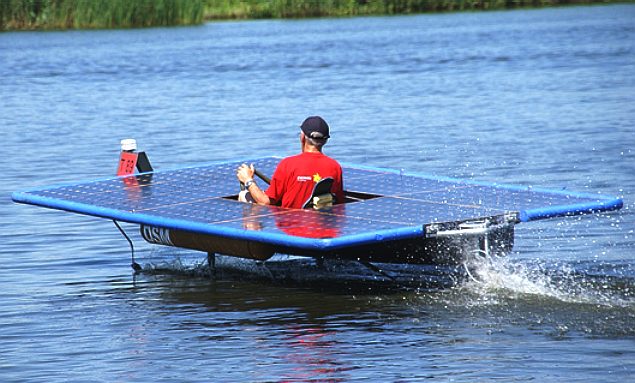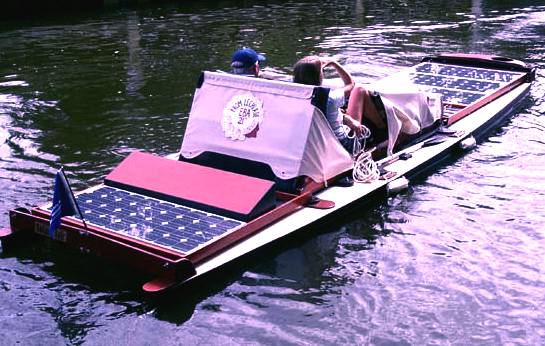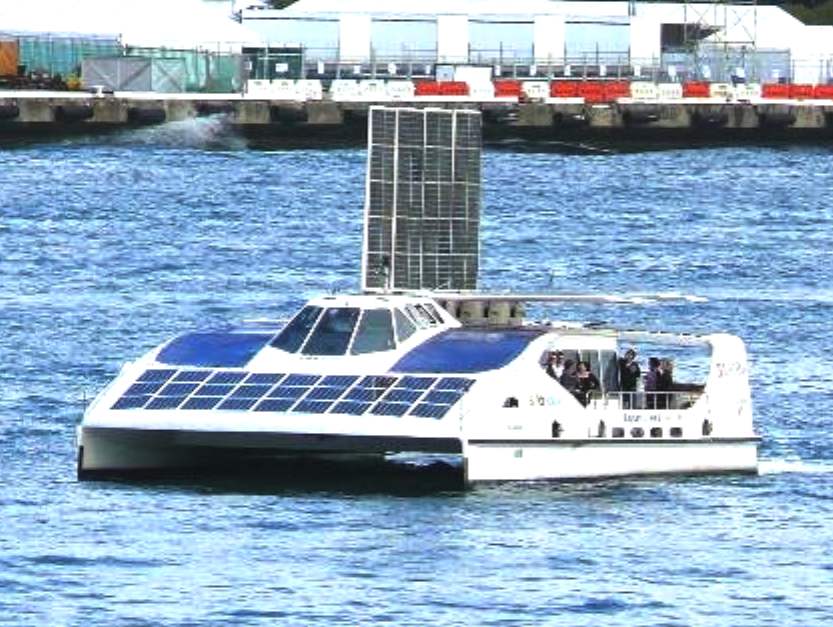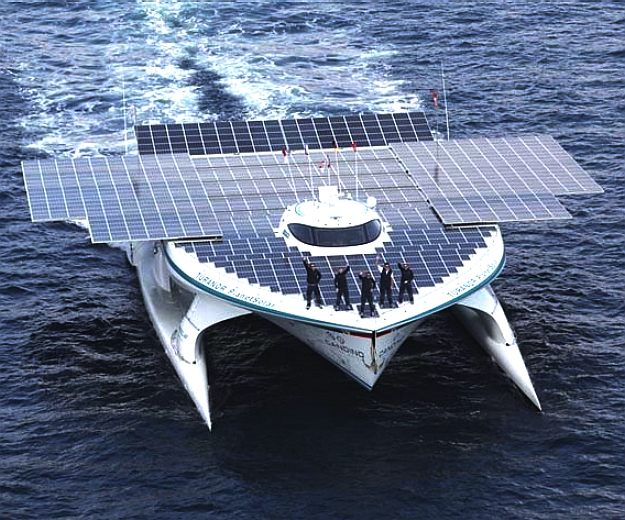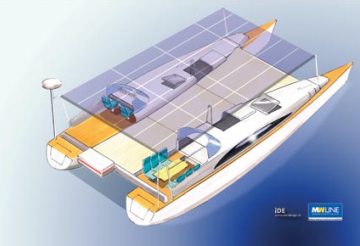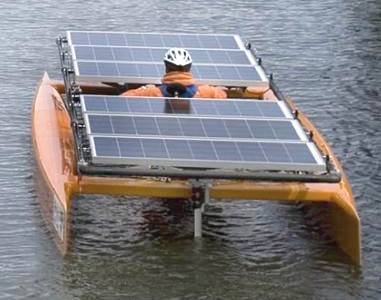|
ELECTRIC & SOLAR POWERED BOATS
|
||||||||||||||||||||||||||||||||||||||||||||||||||||||||||||||||||||||||||||||||||||||||||||||
|
The Turanor PlanetSolar - solar powered catamaran - Click on the picture above to read more
HISTORY OF ELECTRIC BOATS
While a significant majority of water vessels are powered by diesel engines, with sail power and gasoline engines also remaining popular, boats powered by electricity have been used for over 120 years. Electric boats were very popular from the 1880s until the 1920s, when the internal combustion engine took dominance. Since the energy crises of the 1970s, interest in this quiet and potentially renewable marine energy source has been increasing steadily again, especially as solar cells became available, for the first time making possible motorboats with an infinite range like sailboats. The first practical solar boat was probably constructed in 1975 in England.
The first electric boat was developed by Moritz von Jacobi in 1839 in St Petersburg, Russia - a 24-foot (7.3 m) boat which carried 14 passengers at 3 mph. It was successfully demonstrated to Emperor Nicholas I of Russia on the Neva River.
It took more than 30 years of battery and motor development before they began to be deployed in any numbers. In 1886 an electric boat crossed the
English Channel both ways in 8 hours. By 1889 the first 6 electric charter boats were working on the Thames and in the 1893 Chicago World Fair 55 carried more than a
million passengers.
Most of the electric boats of this era were small passenger boats on non-tidal waters at a time when the only power alternative was steam. One of the largest in Britain, and the only surviving example, is the Mary Gordon which was built on the Thames for Leeds City Council for use on the Roundhay Park Lake. It was 52 feet (16 m) long and could take 75 passengers, and is now being restored.
In a few situations, the use of electric boats has persisted from the early 20th century to the present day. One of these is on the Königssee lake, near Berchtesgaden in south-eastern Germany. Here the lake is considered so environmentally sensitive that steam and motor boats have been prohibited since 1909. Instead the Bayerische Seenschifffahrt company and its predecessors have operated a fleet of electric launches to provide a public passenger service on the lake.
In the US, the Electric Boat Company was founded in 1899 and built the first submarine purchased by the U.S. Navy in 1900. Since then, electric power has been used almost exclusively for powering submarines underwater, although diesel was used for powering them on the surface until the development of diesel-electric transmission by the US Navy in 1928. The Electric Boat Company eventually became General Dynamics Corporation in 1952.
The use of combined fuel and electric propulsion has gradually been extended over the years to the extent that some modern liners such as the Queen Mary 2 use only electric motors, powered by diesel and gas turbine engines. The advantages include being able to run the fuel engines at an optimal speed at all times and being able to mount the electric motor in a pod which may be rotated by 360° for increased maneuverability.
The use of electricity alone to power boats stagnated apart from their outboard use as trolling motors until the Duffy Electric Boat Company of California started mass producing small electric craft in 1968. Duffy Boats has produced over 10,000 electric powered boats to date and is producing well over 300 per year today. It wasn't until the 1980s that the Electric Boat Association was formed and solar powered boats started to emerge.
Thought to be the world's most advanced solar powered ship, development of the Elizabeth Swan active SWASH hull platform is underway in 1/20th scale for tank and open water tests, the most important part of which is harvesting energy from nature effectively to provide speeds of 7 knots for cruising and 10+ knots for 10 hour+ dashes to specific locations. The above picture shows the model's solar wings above a supporting frame in wood (aluminium on the final models) and the jig (in white) that is used to assemble each model - three in all.
EB
COMPONENTS
CHARGER
Solar panels can be built into the boat in reasonable areas in the deck, cabin roof or as awnings. Some solar panels, or photovoltaic arrays, can be flexible enough to fit to slightly curved surfaces and can be ordered in unusual shapes and sizes. Nonetheless, the heavier, rigid mono-crystalline types are more efficient in terms of energy output per square meter. The efficiency of solar panels rapidly decreases when they are not pointed directly at the sun, so some way of tilting the arrays while under way is very advantageous.
Towed generators are common on long-distance cruising yachts and can generate a lot of power when travelling under sail. If an electric boat has sails as well, and will be used in deep water (deeper than about 15 m or 50 ft), then a towed generator can help build up battery charge while sailing (there is no point in trailing such a generator while under electric propulsion as the extra drag from the generator would waste more electricity than it generates). Some electric power systems use the free-wheeling drive propeller to generate charge through the drive motor when sailing, but this system, including the design of the propeller and any gearing, cannot be optimised for both functions. It may be better locked off or feathered while the towed generator's more efficient turbine gathers energy.
Wind turbines are common on cruising yachts and can be very well suited to electric boats. There are safety considerations regarding the spinning blades, especially in a strong wind. It is important that the boat is big enough that the turbine can be mounted out of the way of all passengers and crew under all circumstances, including when alongside and when coming alongside a dock, a bank or a pier. It is also important that the boat is big enough and stable enough that the top hamper created by the turbine on its pole or mast does not compromise its stability in a strong wind or gale. Large enough wind generators could produce a completely wind-powered electric boat. No such boats are yet known although a few mechanical wind turbine powered boats exist.
If the boat has an internal combustion engine anyway, then its alternator will provide significant charge when it is running. Two schemes are in use: the combustion engine and the electric motor are both coupled to the drive, or the combustion engine drives a separate generator only, for charging the storage
batteries.
BATTERY BANK
Lead-acid batteries may still be a viable option for cheap builds. Deep-cycle, 'traction' batteries are the obvious choice. They are heavy and bulky, but not much more so than the diesel engine, tanks and fittings that they may replace. They need to be securely mounted, low down and centrally situated in the boat. It is essential that they cannot move around under any circumstances. Care must be taken that there is no risk of the strong acid being spilled in the event of a capsize as this could be very dangerous. Venting of explosive hydrogen and oxygen gases is also necessary. Typical lead-acid batteries must be kept topped-up with distilled water.
Valve-regulated lead-acid (VRLA) batteries, usually known as sealed lead-acid, Gel, or AGM batteries, minimize the risk of spillage, and gases are only vented when the batteries are overcharged. These batteries require minimal maintenance, as they cannot and usually do not need to be refilled with water.
Nickel metal hydride, lithium-ion and other solid-state batteries are becoming available, but are still expensive. These are the kind of batteries currently common in rechargeable hand tools like drills and screwdrivers, but they are relatively new to this environment. They require different charge controllers to those that suit lead-acid types.
Fuel cells or flow batteries may provide significant advantages in years to come. Today (2013) however they are still expensive and require specialist equipment and knowledge.
In conventional electric boats the size of the battery bank determines the range of the boat under electric power alone. The speed that the boat is motored at also affects the range - a lower speed can make a big difference to the energy required to move a hull. Other factors that affect range include sea-state, windage and any charge that can be generated while under way, for example by solar panels in full sun. A wind turbine in a good following wind will help.
SPEED
CONTROL
ELECTRIC MOTOR
Traditional boats use an inboard motor powering a propeller though a propeller shaft complete with bearings and seals. Often a gear reduction is incorporated in order to be able to use a larger more efficient propeller. This can be a traditional gear box, coaxial planetary gears or a transmission with belts or chains. Because of the inevitable loss associated with gearing, many drives eliminate it by using slow high-torque motors. The electric motor can be encapsulated into a pod with the propeller and fixed outside the hull (saildrive) or on an outboard fixture (outboard motor).
TYPES
of ELECTRIC BOAT
CANAL, RIVER and LAKE BOATING
DIESEL-ELECTRIC
HYBRID
SOLAR
POWER
POLLUTION and EMBODIED ENERGY
Pollution
Campbell discusses the pollution that "traditional" batteries put into the water when a boat sinks, but Desmond says that electric boats are no more liable to sinking than other types and lists the leakage of fuel, engine oil and coolant additives as inevitable when an internal-combustion-engined boat sinks. Rutter points to the "very nasty cocktail of pollutants" that come out of a diesel wet exhaust in normal use.
BATTERY MANUFACTURE
The article mentions 25% and 30% discounts being offered to electric boaters by the UK Environment Agency and the Broads Authority and that battery powered vehicles have 3⁄5 the carbon footprint of their petrol equivalents. It is claimed that a typical recharge after a day's cruising costs £1.50, without the use of solar or wind
power. THE WORLD RECORD TO BEAT
Truly an amazing achievement. The Tûranor PlanetSolar ([TPS] from Tolkien) pictured below was launched in March 2010 in Kiel, Germany. The electric circumnavigation took roughly 585 days to complete at an average speed of around 2.63 knots, to set the world's first solar powered record on the 4th of May 2012. For a pioneering first that is quite spectacular running and all of us at Max Energy offer our most heartfelt congratulations to Raphael Domjan and Immo Stroeher. The TPS has proved solar power is viable for blue water transport. The route that this magnificent boat has plied is virtually the same route proposed by the designer of the first Solar Navigator, when he exhibited his SWATH world record contender in December of 1995 at the Earls Court boat show.
So what's next? Well, believe it or not, an autonomous circumnavigation is a looming possibility. Yes, that's right - not a crew member in sight (except as observers) at the helm, the Elizabeth Swan will be able to steer herself around the world in all weathers. The Cleaner Ocean Foundation are insisting on qualified crew in any event, since unmanned boats are a relatively recent development, meaning that it is even more important that the crew know what the vessel is capable of when it comes to writing a Road Test Report.
Solar boats tick a number of boxes for the United Nations in terms of climate change and marine conservation, where the elimination of conventional bunker fuels would be a major step forward in fighting acid oceans. These are known as Sustainability Development Goals or SDGs.
FUTURE WORLD CONTENDERS
Electric boats have been plying waterways in Europe since around 1890. In 1905 the 'Victory' was launched on the River Thames, at that time the largest electric boat in the world. She was 93 feet long and wood built. The Victory could carry 350 passengers. Before the internal combustion engine became popular electric boating rivaled steam and horse drawn barges. Battery powered pleasure-boats were charged-up by steam powered generators and overhead cables. In England canals provided a comprehensive network for working narrow-boats carrying cargo. After 1905 the internal combustion engine became popular, ironically, due the the invention of the electric starter motor.
There are a growing number of solar powered boats and boat events.........
In Europe -
Another Solar Navigator (test rig) heading into wind - the latest design in soon to be on display for the Jules Verne Solar Trophy, which does not need to be an 80 day circumnavigation.
In the USA -
DSE Island Pilot hybrid solar/diesel electric
Solar Boats Built by Engineering Students Wins National Competition Mailing list for Solar BoatsWorld championship of solar-electric regata
In Canada - Solarboat projectSolar kit for boat
Solar Loon - Monte Gisbourne, Ontario
In Australia - Solar Sailor
In Japan - First Solar Pacific Crossing
Cedric Lynch testing a solar powered canoe
The solar canoe above is owned by Cedric Lynch. It was featured in the Guinness Book of Records and held the record speed for a solar-powered boat. Source: EBA
Energy - Environement
Planair in La Sagne Switzerland. Solar energy links
SSES, Société Suisse Energie Solaire Switzerland Service cantonal de l'Energie, Neuchâtel Switzerland Futurebike, Human Powered Vehicles (HPV) Switzerland Swissolar Switzerland Solarserver Germany Solarpolis Germany A lot of links in Austria Dong Energy Solar Challenge new v20 standard class in 2014 https://www.facebook.com/SmartCommunitySocialLab http://www.savonelectric.com/electrical-news/china-electric-ferry-is-a-solar-boat
The Oarsman's and Angler's Map of the River Thames from its source to London Bridge (1991. Old House Books, Devon ed.). James Reynolds & Son, London. 1893. Electrical Review Vol 201 No 7 12 August 1977 The story of solar powered boats http://www.elcomotoryachts.com/history.shtml Mary Gordon Electric River Boat Bayerische Seenschifffahrt GmbH Bavarian Lakes Maritime Ltd Bavarian State Ministry of the Interior. Geschichtliche Hintergründe Historical Background Bayerische Seenschifffahrt General Dynamics Corporation, Encyclopædia Britannica, 1993 The world's first crossing of the Atlantic on a solar boat EERE News: EERE Network News - December 06, 2006 ISSN 3315 0950 3315 MS Tûranor PlanetSolar yacht completes her first tour around the world with a success Charterworld.com Alternative Energy and Fuel News: ENN - Know Your Environment http://www.solardaily.com/reports/Japan_launches_first_solar_cargo_ship_999.html http://www.smh.com.au/news/National/Solar-ship-sails-the-ocean-green/2005 The world's first gigayacht Motor Boat Monthly. 11 June 2010. Electric Boat Association (UK nonprofit) Electric Boat Association (Australia nonprofit) Electric Boat Association (US nonprofit) Electric Seas Organization (US nonprofit)
Solar Navigator 2nd SWATH development model displayed in the Eastbourne Arndale centre in 1996, the 1st SWATH vessel at Earls Court in 1995
Solar Boat model by Jorma Ponkala
Energy - Environment
ASV - Unmanned Systems Babcock International Group plc Baltic Ace - cargo vessel collision Boat patent - autonomous vessels Boat patent - foil wing sails CHARC - Lockheed Martin concept vessel ClassNK - Japanese ship classification society Costa Concordia - accident pictures and salvage operation Exxon Valdez - Oil tanker disaster, Alaska Ghost - Juliet Marine Hamster Wheel Catamaran - Chris Todd's Irish Sea adventure Hawkes - Minisubs International Maritime Organization Lockheed Martin - Marine fittings, specialist services and parts Maritime and Coastguard Agency - MCA Mine Hunters, mine sweepers - National Environment Research Council - National Oceanographic Center - Southampton, UK NAVSAC - Navigation Advisory Safety Council Northrop Grumman - Pearly Miss 13' aluminum sports boat Predator - Submarine hunter/killer patent minisub Protector - Raphael Armaments drone boat Ship Owners Trust - International Cargo Technology Strategy Board - Autonomous Navigation Top Gun - Electric Cigarette boat record Torrey Canyon - Oil tanker disaster, Bligh Reef
|
||||||||||||||||||||||||||||||||||||||||||||||||||||||||||||||||||||||||||||||||||||||||||||||
|
This website is Copyright © 1999 & 2019 Max Energy Limited, an environmental educational charity working hard for world peace. The names Solar Navigator™,Blueplanet Ecostar BE3™ and Utopia Tristar™ are trademarks. All other trademarks are hereby acknowledged.
|
||||||||||||||||||||||||||||||||||||||||||||||||||||||||||||||||||||||||||||||||||||||||||||||
